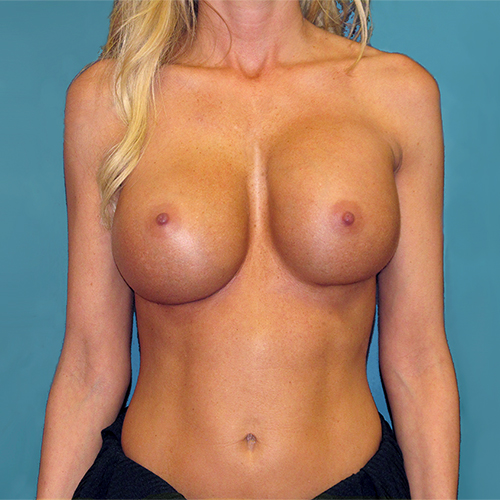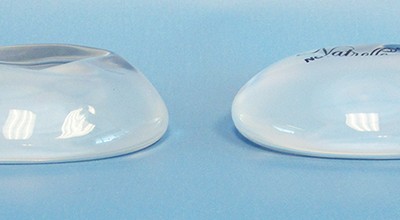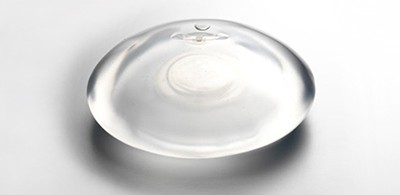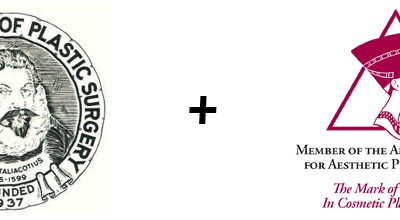
Capsular Contracture
The most common complication in breast augmentation is capsular contracture. Rates of capsular contracture have been reported ranging from 0.5% to 20%.
Because the breast implant is a foreign object and material, it does not become integrated into the body. Instead, the body forms a thin fibrous capsule around the breast implant. Every breast implant has a capsule around it. This capsule is a thin fibrous layer of (scar) tissue. In most cases this capsule remains soft and pliable and has minimal effect on the contour or feel of the breast.
In some situations, the capsule undergoes progressive shrinkage, along with potential thickening, in a process knowing as contracture. When this occurs, the breast implant is gradually deformed by the tightening capsule. The implant begins to assume a more spherical shape; as the contracture worsens the implant is forced into an unnatural spherical contour. As capsular contracture progresses the breast will become more firm. Capsular contracture can change the size, shape, and/or position of the breast implant.
In a mild form, capsular contracture may go unrecognized, or may not appear particularly significant. These mild contractures do not usually require treatment. Mild capsular contractures that occur in both breasts may not be recognized, or viewed as problematic, by patients because symmetry between the breasts is relatively maintained. In more severe cases the breast can become quite firm, develop a distorted spherical shape, and may become painful. These characteristics are problematic, and patients often seek treatment.
The Baker Classification System for Capsular Contracture
Capsular contractures are graded I through IV using the Baker classification. In this classification system, Grade I refers to breasts that are soft to palpation, and easily compressible; the breast looks and feels normal. Grade II is assigned to breasts that are more firm than desired, but lack any visual changes or deformity. A Grade III capsular contracture produces a visual deformity of the breast, usually apparent as a spherical breast shape. A Grade IV contracture is characterized by extreme firmness, pronounced deformity, pain or tenderness, and sometimes coolness to the touch.

Grade III Capsular Contracture of the Left Breast
{insert pictures of Grade I – IV}
What Causes Capsular Contracture?
The cause of capsular contraction is unknown, but it is likely related to some sort of scarring process. Abnormal or excessive scarring may manifest in some individuals, for reasons that are unknown. Or, the capsule might form following some inflammatory process that induces additional scarring around the implant. Capsular contracture has occurred following hematoma, seroma, and sub-clinical infection.
Unfortunately, every woman with breast implants is at risk for capsular contracture. Capsular contracture can occur early after surgery, many years following surgery, in one or both breasts, with subglandular or submuscular implants, with smooth or textured implants, and with saline or silicone gel implants. It is not possible to predict which individuals will develop capsular contracture. And there is not a specific procedure, treatment, or medication to prevent capsular contracture from forming.
How Do You Reduce The Risk Of Capsular Contracture?
The best way to reduce the occurrence of capsular contracture is to reduce prolonged inflammation and the possibility for scarring. This is best done during the surgical procedure. Utilizing an operative approach that minimizes the risk for infection, minimizes pocket manipulation and reduces tissue trauma, minimizes bleeding, and involves minimal implant handling should reduce the risk for capsular contracture. Pre-operative i.v. antibiotics, utilizing a submuscular pocket, rinsing the pocket with antibiotic solution, and minimizing contact between the breast implant and the skin will reduce the risk for infection. Precise surgical technique will reduce the risk of bleeding and minimize tissue trauma. These specific approaches should minimize infection, bleeding, and seroma formation; thereby reducing post-operative inflammation and the subsequent risk for scarring and capsular contracture.
Capsular contracture may also be affected in other ways. The subglandular space has a higher incidence of capsular contracture. Placing the breast implant in the submuscular position has been shown to minimize the risk of capsular contracture. In the submuscular position the implant is continually massaged by the pectoralis major muscle with arm and chest movements. This implant massage likely places pressure on the capsule, reducing the risk for contraction. In the submuscular position there is also less risk for bacterial contamination of the implant from the breast ducts.
Textured implant surfaces have been shown in some studies to reduce the incidence of capsular contracture, compared with smooth surface implants, when placed in the subglandular position.
Some surgeons recommend the institution of early post-operative implant displacement exercises to stretch the capsule. Although this technique is rather widely utilized, no studies have ever shown that implant displacement exercises reduce the risk of capsular contracture.
[more to come]
NEXT TOPIC: Unexpected Outcomes and Complications
What is the Gel-to-Shell Fill Volume Ratio?
Each round silicone gel-filled breast implant is comprised of a silicone elastomer shell which contains the silicone gel filling. Silicone gel breast implants are filled by the manufacturer with a moderately cohesive (responsive) silicone gel. If you look carefully at...
How Firm is a Saline Breast Implant?
During the consultation today, a patient asked me, "Aren't saline implants harder?" Well, it actually depends. Let me start by saying that if you have ever held a saline implant and a silicone gel implant side-by-side, you know that they feel completely different, and...
Why is a board certified plastic surgeon important for my breast augmentation?
I recently saw a woman in consultation for a failed saline breast implant. She had her breast augmentation performed seven years earlier by a surgeon who advertises like a plastic surgeon, but is not board certified in plastic surgery. And as far as I am aware, has...



